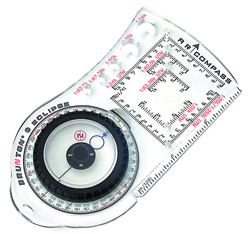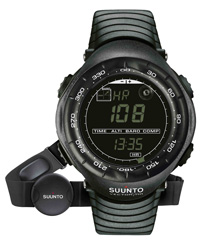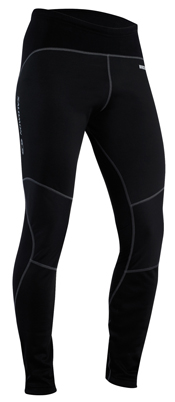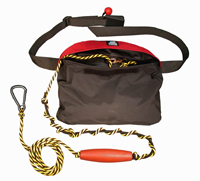I wore the Reactor Max prescription glasses from Smith Optics while cycling and throughout other disciplines on the course. The glasses, which I have used for a couple years now, have a solid frame and quickly interchangeable lenses. I have two sets of lenses, one clear and one a sunglass. In the Patagonia race, I would switch out as needed for bright, low-light and after-dark scenarios.

Navigation is a huge component in wilderness racing. The far-south latitudes of the Patagonia race required special navigational tools. Namely, compasses had to be set to a different magnetic sensitivity than northern-hemisphere models. I turned to Brunton and its $40 Eclipse 8096 model, which is a compass designed specifically for adventure racing. It has UTM scales on its baseplate and markings to work with other types of cartographical coordinates. But to tune the Brunton to the southern hemisphere, the company had to rebalance the needle, which required a special order and some in-house recalibration at the company.
An easier solution is Suunto’s M-3 Global Compass, which costs about $55. It comes with a “global needle” that is designed to work with the magnetic spectrum anywhere on the planet. I tested both the Brunton and Suunto models on the race. Both needles pointed the same way, which is to say straight at magnetic north. They were equally accurate for more than 300 miles of navigation in the Chilean wilds.

Another Suunto product provided time, altitude and an alarm. The $329 Vector HR watch has in total an altimeter, barometer, electronic compass, time, alarm, and a heart rate monitor. Its functions all performed with aplomb in Patagonia — except for the alarm. The small beep emitted when the alarm clicks on to ostensibly wake a team of racers is too quiet. Like many watches in this category, a louder beep would be welcome.
Running tights — not pants — were my leg wear of choice. Salomon’s WS II Tights were most impressive. I wore the durable WS IIs for four days straight, including while bushwhacking in deep, thorny forests and while mountaineering. The tights, which cost $110, have a Gore Windstopper Softshell on the front of the legs to provide protection from big breezes in cold climates. But the tights breathe well.

My legs felt comfortable in temps from about 30 to 55 degrees F on the race. Bonus: The material never ripped or snagged. I have had problems with tights and durability in past races, but the Salomons did not let me down.
Food — in the guise of 6,000 or 7,000 calories per day — is an immense part of the planning and preparation for this race. I will address my food plan in a separate column. But quickly, for this race I got serious about my food choices, including the recruitment of help from Tara DelloIacono Thies, the nutrition strategist at Clif Bar & Company. Tara and I concocted a day-by-day meal plan for the course, including the creation of dozens of 200 to 300-calorie baggies I could grab and eat. Each baggie contained different foodstuffs — nuts, dry fruit, croutons, chocolate, and, or course, Clif products like the gummy SHOT Bloks and salty Mojo bars, both of which I loved on the race.

Each day’s rations included about 20 of the aforementioned 200 to 300-calorie baggies. I would try to eat one baggie of food per hour, thus (theoretically) keeping energized the entire trip. I took electrolyte pills for salt. I drank water as well as sports products like Hammer Nutrition’s Perpetuem, nuun tablets, and Zym Catapult electrolyte tablets. The entire mix worked well, keeping me from bonking and cramping most of the race. In the end, I lost about seven pounds on the trip, which was expected.
Big, cold ocean water, including the Strait of Magellan and the Beagle Channel, were venues in the race. As such, our sea kayaking equipment was top end. Like all the teams, we paddled two-person Necky Amurak kayaks, comfortable and stable plastic-hull boats. We were outfitted head to toe by Kokatat Watersports Wear, which lent Team GearJunkie.com demo dry suits, PFDs, skirts, gloves, and booties.

Overall, the GORE–TEX Front Entry Dry Suits from Kokatat were bomber. At $899, they don’t come cheap. But in big water the extra protection is needed. In a pre-race kayak test on the Strait of Magellan, the Wenger race staff required a boat evacuation and self-rescue. As such, we capsized our crafts out from shore in the frigid water. We swam in our dry suits and clambered back into the boats, bailing them out before continuing on. It is amazing the amount of protection a thin suit can provide. In the icy water, my team felt fine bobbing in waves and righting boats as a large sea lion swam by.
We had less luck with the company’s GORE–TEX Deluxe Sea Skirt. The $167 spray skirt was difficult to attach to the cockpit on the Necky Amurak kayaks. Its fit was too tight and would pop its seal if not meticulously secured with two hands pressing and kneading the elastic fabric in place 360 degrees around the cockpit edge before leaving shore. A different size skirt or a sharper edge on the Necky Amurak would have made it an easier task.

Other kayaking gear of note included the Orbit Tour PFD from Kokatat, a $142 low-profile life vest that was great while paddling. Tow systems were required gear, and our team chose the $99.95 QR Rescue Tow Line from North Water Ltd. A quick-release mechanism at the rescuer’s end of the line, a brass eye hook for anchoring, and 55 feet of floating polypropylene rope made it a perfect choice for our tow-line needs. But fortunately, despite the big water and wind, we never employed the North Water gear during the event.

For team paddles, we picked a wing-blade set from Lendal. The company’s Kinetik Wing and Kinetik Wing S are similar models, though of slightly different size. They provide a unique wing blade that adds efficiency to each stroke. At more than $500 apiece, the Lendals are top-end carbon tools.

But in a big race where any efficiency gain can be had through gear, sometimes the extra cost is worth the speed. On the Beagle Channel, we nailed a 29-mile section with waves, swells and big wind. The Lendal paddles gave us confidence as well as enough speed to pass several teams on the section.
continued on next page. . .








